Arp 272 is a pair of colliding galaxies located approximately 450 million light years away in the constellation Hercules. The interacting duo is catalogued as NGC 6050 in the New General Catalogue and IC 1179 in the Index Catalogue. The designation Arp 272 comes from Halton Arp’s Atlas of Peculiar Galaxies (1966).
The two spiral galaxies, NGC 6050A and NGC 6050B, are interacting with a fainter companion, catalogued as SDSS J160522.48+174534.7. The triplet of interacting galaxies will eventually merge to form a single larger galaxy.
The two colliding spiral galaxies are linked by their spiral arms. The galaxies’ disturbed morphologies and the close projected distance between them are strong indicators that the galaxies are physically interacting and not just appearing in the same line of sight. The two galaxies are listed as KPG 481 in Karachentsev’s Catalogue of Isolated Pairs of Galaxies.
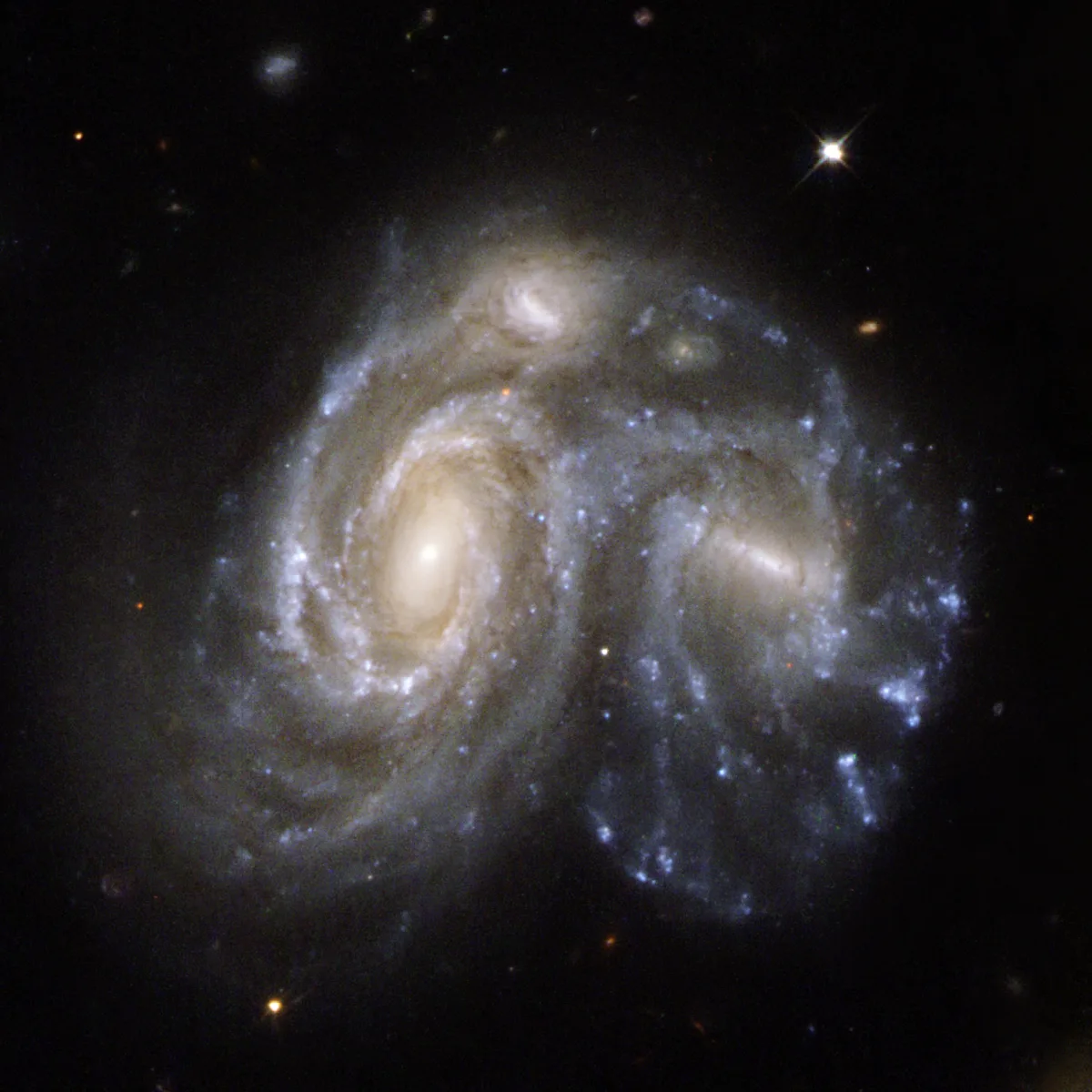
NGC 6050/IC 1179 (Arp 272) is a remarkable collision between two spiral galaxies, NGC 6050 and IC 1179, and is part of the Hercules Galaxy Cluster, located in the constellation of Hercules. The galaxy cluster is part of the Great Wall of clusters and superclusters, the largest known structure in the universe. The two spiral galaxies are linked by their swirling arms. Arp 272 is located some 450 million light-years away from Earth and is the number 272 in Arp’s Atlas of Peculiar Galaxies.
This image is part of a large collection of 59 images of merging galaxies taken by the Hubble Space Telescope and released on the occasion of its 18th anniversary on 24th April 2008. Left: NGC 6050A. Right: NGC 6050B. Image credit: NASA, ESA, the Hubble Heritage (STScI/AURA)-ESA/Hubble Collaboration, and K. Noll (STScI) (PD)
NGC 6050A is an unbarred spiral galaxy with an apparent visual magnitude of 15.2 and an apparent size of 0.903 by 0.687 arcminutes. A 2009 study detected an active galactic nucleus (AGN) in the galaxy, a compact region in the galactic core that shows excess emissions across the electromagnetic spectrum. The emissions are believed to come from the accretion of material by a central supermassive black hole.
NGC 6050B is a barred spiral galaxy with an apparent magnitude of 16.3 and an angular size of 0.62 by 0.43 arcminutes. The smaller and fainter SDSS J160522.48+174534.7 has a visual magnitude of 17.2.
NGC 6050A, NGC 6050B and SDSS J160522.48+174534.7 are part of the Hercules Cluster (Abell 2151), a massive cluster of galaxies within the larger Hercules Supercluster. The Hercules Supercluster is itself part of the Great Wall (CfA2 Great Wall), one of the largest superstructures known in the universe.
The Hercules Cluster contains around 200 member galaxies. These galaxies lie approximately 500 million light-years away. The cluster contains numerous spiral galaxies, many of which are in the process of interacting and colliding, much like Arp 272. The brightest member of the cluster, the giant elliptical galaxy NGC 6041, lies about 2 arcminutes away from Arp 272.
Other members of the Hercules Galaxy Cluster that lie in the vicinity of NGC 6050 include IC 1182, NGC 6045, NGC 6054, and NGC 6047. The interacting pair NGC 6040 (Arp 122) lies closer to the giant elliptical NGC 6041.
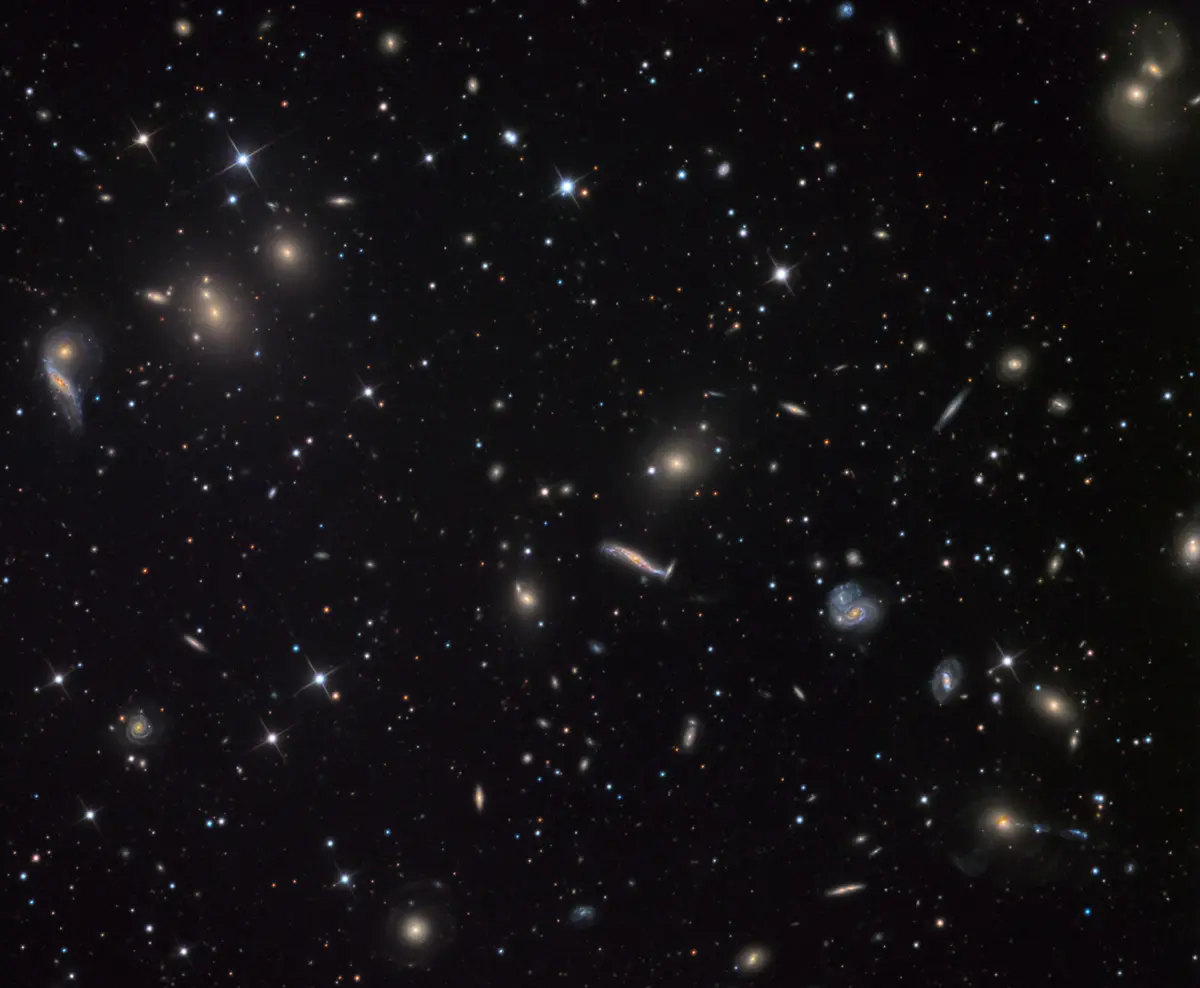
Hercules Cluster of galaxies, image credit: Adam Block/Mount Lemmon SkyCenter/University of Arizona (CC BY-SA 4.0)
Facts
Arp 272 was discovered by the American astronomer Lewis Swift in the 1860s. Swift observed the galaxy on June 27, 1886, and the object was later listed as NGC 6050 in the New General Catalogue. He observed what was presumably the same object on June 3, 1888, and this led to the galaxy being listed as IC 1179 in the Index Catalogue.
The catalogue designation IC 1179 has been the cause of some confusion. Some sources use it for NGC 6050B, while others use it for the interacting pair. Since Lewis Swift in all likelihood could not have observed Arp 272 as anything but a single object, IC 1179 is probably the same object as NGC 6050. For this reason, the two galaxies are referred to as NGC 6050A and NGC 6050B or IC 1179A and IC 1179B.
NGC 6050A and NGC 6050B have the designations PGC 57058 and PGC 57053 in the Principal Galaxies Catalogue, or LEDA 57058 and LEDA 57053 in the Lyon-Meudon Extragalactic Database (LEDA).
The galaxy IC 1179 hosted a supernova, SN 2006cd, observed in 2006. SN 2006cd was catalogued as a Type II-P supernova, caused by a rapid core collapse of a massive star. At the time of discovery, it had an apparent magnitude of 18.3.
The Simbad database lists the three interacting galaxies as members of the compact galaxy group SDSSCGB 4240 (MLCG 0372). The smaller and fainter galaxies PGC 1540468 (LEDA 1540468) and PGC 1540575 (LEDA 1540575) are also listed as members.
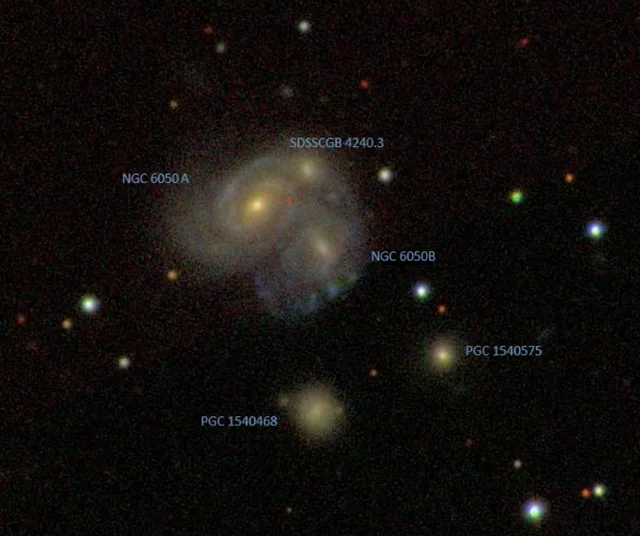
MLGC 0732, image credit: ESO/Digitized Sky Survey 2 (CC BY 4.0)
Location
Arp 272 lies in the southern part of the constellation Hercules, near the border with Serpens. It appears along the imaginary line drawn from the white giant Gamma Herculis to the binary star Zhou (Beta Serpentis). Gamma Herculis appears south of the brighter Kornephoros (Beta Herculis), and Zhou forms the Serpent’s head with Gamma Serpentis and Gudja (Kappa Serpentis).
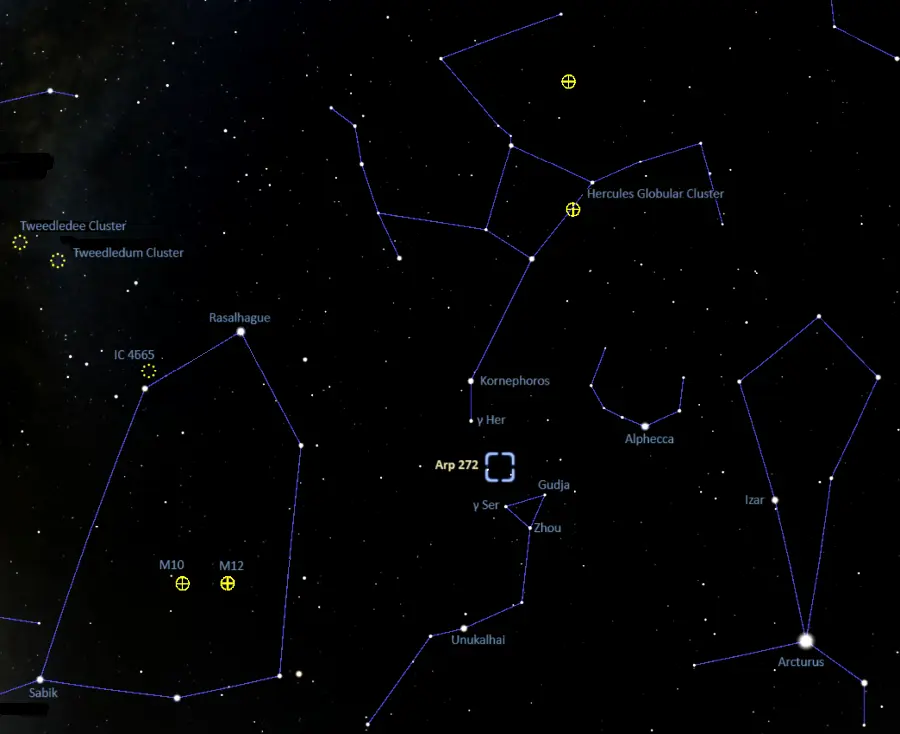
The location of Arp 272 (NGC 6050), image: Stellarium
Arp 272 – NGC 6050
| Constellation | Hercules |
| Object type | Interacting galaxies |
| Distance | 494.13 ± 55.89 million light-years (151.5 ± 17.137 megaparsecs) |
| Names and designations | Arp 272, NGC 6050, IC 1179 |
NGC 6050A
| Object type | Spiral galaxy |
| Morphological type | SA(s)c |
| Right ascension | 16h 05m 23.3675247552s |
| Declination | +17° 45′ 25.766586684″ |
| Apparent magnitude | 15.2 |
| Apparent size | 0.903′ × 0.687′ |
| Redshift | 0.031928 |
| Heliocentric radial velocity | 9,572 km/s |
| Names and designations | NGC 6050A, IC 1179A, Arp 272a, VV 220a, KPG 481b, LEDA 57058, PGC 57058, MCG+03-41-092, UGC 10186, 2MASX J16052336+1745258, SDSS J160523.36+174525.7, SDSS J160523.36+174525.8, UZC J160523.3+174526, Gaia DR2 1199936626108197376, Gaia DR3 1199936626108197376 |
NGC 6050B
| Object type | Spiral galaxy |
| Morphological type | SB(rs)cd |
| Right ascension | 16h 05m 22.218s |
| Declination | +17° 45′ 15.05″ |
| Apparent magnitude | 16.3 |
| Apparent size | 0.62′ × 0.43′ |
| Redshift | 0.037116 |
| Heliocentric radial velocity | 11,127 km/s |
| Names and designations | NGC 6050B, IC 1179B, Arp 272b, KPG 481a, VV 220b, LEDA 57053, PGC 57053, AGC 261077, MCG+03-41-093, SDSSCGB 4240.1, SDSS J160522.21+174515.0, UGC 10186a |
SDSS J160522.48+174534.7
| Object type | Galaxy |
| Right ascension | 14h 35m 06.354s |
| Declination | +17° 45′ 35″ |
| Apparent magnitude | 17.2 |
| Redshift | 0.034239 |
| Heliocentric radial velocity | 10,265 km/s |
| Names and designations | SDSS J160522.48+174534.7, SDSS J160522.48+174534.6, SDSSCGB 4240.3, NFP J160522.5+174535 |
Images
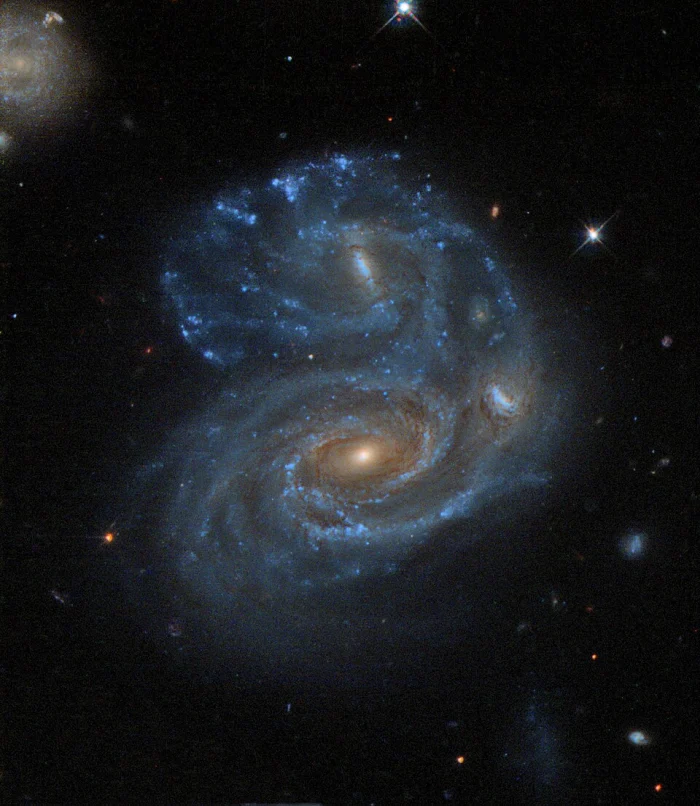
A lovely trio of interacting of galaxies in the Hercules Cluster. Tricolor image taken from HST in 2007. Credit: NASA/ESA/STScI/Hypatia Alexandria (CC BY 2.0)
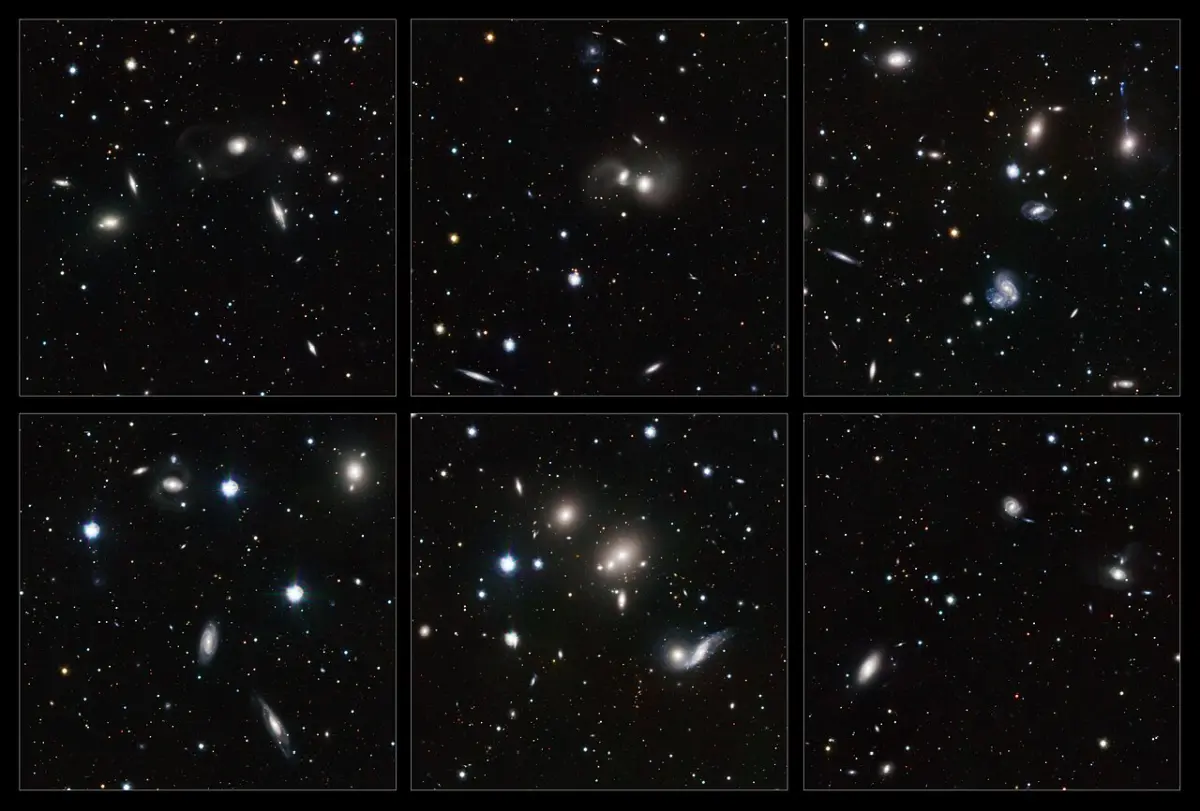
These highlights, taken from a new image of the young Hercules galaxy cluster from the VLT Survey Telescope (VST) and the OmegaCAM camera, show a wide variety of interacting galaxies. The numerous interactions, and the large number of gas-rich, star-forming spiral galaxies in the cluster, make the members of the Hercules cluster look like the young galaxies of the more distant Universe. Image credit: ESO/INAF-VST/OmegaCAM. Acknowledgement: OmegaCen/Astro-WISE/Kapteyn Institute (CC BY 4.0)